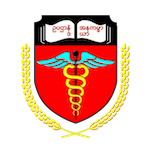English is taught in the first year for one academic year. The aim of the course is to develop the student’s language skills in order that they may be able to cope with their content subjects not only in the premedical and pre-clinical years but also with continuing education, including their postgraduate studies. To that end, and for effective teaching, proficiency is developed by means of small group teaching and tutorials. Self-directed learning is also encouraged through extensive extra-curricular reading.
The student is trained to listen or read and understand the nuances of a Myanmar text and speak the language fluently, to write grammatically correct sentences, and to have a basic knowledge of translation. To help the students acquire this tool for communication, the syllabus provides for writing practices in essays, precis, pamphlets and slogans, and sessions for developing verbal communication skills in giving health education talks to the general public.
The student is introduced to computing methods and techniques required for practical work and research, and trained in mathematical modeling of an interpretation of results in biological and medical sciences. The syllabus includes Functions and Real Number System, Trigonometry, Algebra, Differential Calculus, Integral Calculus, Probability & Statistics.
The aim of the course is to enable the students to understand the basic concepts and fundamental principles in Physics and apply them in their medical studies, in the use of common modern medical and dental equipment. To that end, the course introduces the student to the mechanics and properties of Matter, Heat, Sound, Light, Electricity and Radiation.
The course is an introductory to the preparatory for para-clinical and clinical studies. Thus, it includes the fundamental principles of Chemistry with a view to its application in later years, and lays a foundation for the scientific approach in medical studies. The syllabus consists of Inorganic and Physical Chemistry, and Organic Chemistry. The former touches on the atomic structure and chemical bonds, the gaseous state, solutions, chemical thermodynamics and kinetics, life’s essential elements, water, surface chemistry. Organic Chemistry deals with hydrocarbons, alcohol, alkyl halides, ethers, carbonyl compounds, monocarboxylic acids and derivatives of acids, amines, aromatic compounds, stereochemistry, carbohydrates, amino acid, proteins, and lipids.
The course introduces the students to the characteristics of life and living processes and how the plant world provides basic human requirements. The students also learn about medicinally important plants as they play an important role in the study of indigenous medicine. The syllabus consists of functions of living things, plant physiology, genetics, medicinal plants and vitamins, and ecology.
The course aims to enable the students to acquire knowledge of living organisms, differentiate animals to correlate the relationship between the animal and its environment and acquire prerequisite knowledge, skills and attitudes for basic medical studies and develop learning behaviour suitable for continuing medical education. The syllabus therefore includes the views of life, the kingdoms of animal life, animal behaviour, evolution and the human organism.
